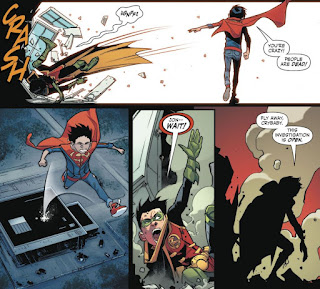
The Death of Superman was released on digital on July 24th and on Home Video on August 7th. Directed by Jay Olivia and written by Peter J. Tomasi, it adapts the famous 1992 Death of Superman story-line from the comics.
I was highly skeptical going into The Death of Superman. DC had already attempted to do an animated adaptation of this story with the mediocre Superman: Doomsday from 2006. The reason the original story had such an impact was that it killed off this beloved, established character so Doomsday had a disadvantage because the version of Superman featured in that film didn't have any long established canon so the audience didn't have the same emotional attachment to him. This film alleviates that problem somewhat as it exists in a connected movie universe. Despite this I was still really unsure. The characterization of Superman in the DC Animated Movie Universe up to this point had been pretty inconsistent and his relationship with Lois Lane, an integral part of the emotional weight of this story, had barely been established as Superman had been romantically involved with Wonder Woman (à la Geoff Johns Justice League). To make matters worse, the trailer for the movie made it look pretty awful.
Despite all of these reservations I still held out some hope. The films in the DC Animated Movie Universe have gotten increasingly better since the incredibly forgettable Justice League: War. Justice League vs. Teen Titans and, in particular, Suicide Squad: Hell to Pay were both really solid comic book films. When I finally sat down to watch the movie I was kind of blown away by how good it was. I'm not saying it's a great film but it exceeded my (admittedly low) expectations.
The film has really solid writing. Wisely, it focuses on Clark's relationship with Lois but, unlike in the comics, Lois doesn't know that Clark is Superman at the beginning of this story. His arc is learning to trust her with his secret, so when he finally decides to tell her, mere minutes before going off to fight Doomsday, it makes it all the more tragic when he dies. The film also takes time to establish how important a force Superman is in people's lives. Whether it's Bibbo Bibbowski getting Jimmy Olsen to take his picture when he shakes hands with the Man of Steel or Hank Henshaw assuring his fellow astronauts that Superman will come to their rescue as a comet hurtles toward their ship, the film really makes it clear that Superman is a source of hope and inspiration.
The film also does a good job slowly building up to the fight with Doomsday. As in the comics, there's no attempt to tie him to Superman's origin or make him a creation of Lex Luthor (as in Batman v Superman and Superman: Doomsday). He's simply an alien monster. It's precisely this vague ambiguity that makes the creature such a palpable threat for Superman. A character who's is invulnerable by his very nature could only be defeated by a force of nature such as Doomsday. As the story progresses it becomes more and more clear just how dangerous Doomsday is. We first see him kill a few Atlantean soldiers but by the time Superman faces him he has nearly destroyed the Justice League. This helps to create an increasing sense of dread.
Finally, The Death of Superman does a good job setting up the sequel, Reign of the Supermen, organically. Hank Henshaw, John Henry Irons, Eradicator, and Superboy (Conner Kent) are all introduced throughout the course of the story but it doesn't feel forced or shoehorned in. Hank Henshaw is in the spacecraft which the meteor containing Doomsday crashes into on the way to earth. The kryptonian birthing matrix, which I assume is connected to Eradicator, is shown when Superman shows it to Lois for an interview for the Daily Planet. John Henry Irons is one of the scientists investigating the fragments of Apokolips technology which Superman recovered after his fight with members of Intergang. These fragments lead Superman to Lexcorp, where Luthor is experimenting with Earth/Apokolips technology to create a clone of Superman (presumably Connor Kent).
As with most of these DC direct-to-video efforts, the animation is just ok. It shines the most during the fight scenes, with are incredibly energetic and also have a good sense of weight and scale. I'm not of fan of the costume design in these movies, based on Jim Lee's New 52 designs, but that's more of a personal pet peeve then anything else. The voice cast is all solid. Jerry O'Connell has really grown on me as Superman and Rebecca Romijn (best known for playing Mysitique in the X-Men movies) makes a really spunky, no-nonsense Lois Lane. The always dependable Rosario Dawson also did a good job as Wonder Woman. The one weak spot is Rain Wilson who is simply miscast as Lex Luthor. Perhaps they wanted to go for a Jesse Eisenberg vibe (though I can't imagine why), but the character isn't written that way and Wilson's high register sounds out of place coming from this masculine looking business man.
The Death of Superman isn't breaking any new ground for the genre but it's a solid adaptation of the classic story and a step in the right direction for the DC Animated Movie Universe. I'd definitely recommend it to any fan of Superman or superhero comics in general.
Score: 8/10









































